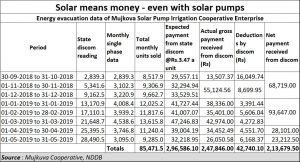https://www.moneycontrol.com/news/business/economy/how-two-villages-harnessed-solar-pumps-to-create-incomes-for-farmers-conserve-groundwater-4381161.html
Harnessing solar pumps to create additional incomes for farmers
RN Bhaskar — Aug 28, 2019
This is a story of a brilliant concept that NDDB came up with – along the state power distribution company (discom) – which has become a great new business opportunity for farmers. More importantly, it has also conserved underground water reservoirs.
 When the concept of solar pumps was first mooted, some ten years ago, as a good solution for farmers without grid connectivity, this author was vehemently against the proposal. The reason?
When the concept of solar pumps was first mooted, some ten years ago, as a good solution for farmers without grid connectivity, this author was vehemently against the proposal. The reason?
With grid connectivity, the farmer knows that he is being billed for the water pumped out of the ground or the reservoir (even if the tariffs are at a subsidised rate of Re.1 per unit). Hence, he has an intuitive awareness of a ticking electric meter billing him for the units consumed. He therefore turns off the pump when he thinks he has enough water.
With solar pumps, there is no need for such intuitive awareness. There is no billing, hence no compulsion. The tendency to draw out much more water remains unchecked. Resultantly, more water gets pumped out than is warranted with disastrous consequences for the ecology.
But the lobby of solar pump producers has been strong enough to convince the government otherwise. Consequently, India saw the number of solar pumps swell from 7,000 in 2010 to over 128,000 by mid-2017. Business was good, never mind the over-drawing of groundwater.
Enter SPICE
But four years ago, NDDB’s engineers hit upon a brilliant idea. They knew that the farmer had to be incentivised to switch off his water pump. Hence, they could band together a group of farms, create a micro-grid, tell the farmers that they could sell to the state grid the surplus power that they did not need. The farmer would thus get an additional source of income.
Great idea! But would it work?
So, NDDB decided to set up two pilot projects – one at Dhundi village in 2016, and the other at Mujkuva village in 2017. They called this project, Solar Pump Irrigators’ Cooperative Enterprises (SPICE). Both villages had farmers with expensive and polluting diesel pump sets. They were persuaded to band themselves into a collective, opt for solar pumps, and then set up a micro-grid.
They then roped in the discoms’ officials and told them to purchase power from the microgrid – where the power was aggregated and levelled (because solar power can be intermittent and uneven in flow). The discoms agreed to a feed in tariff (FIT) of Rs.4.63 at Dhundi and Rs.3.47 at Mujkuve.
Initially, as happens with most new ideas, the farmers were sceptical. But soon they realised that the earnings could be substantial. Today, each farmer in the cooperatives earns around Rs.5,000 per month from the sale of power alone.
But the going was not easy. First, the farmers had to be taught to keep the solar panels clean and the electrical equipment ship-shape. While earlier, they would not have bothered, they now became careful lest they lose precious rupees each month.
The next problem was (rightfully) with the state discoms. The discoms provide power to the farmers at a subsidised Re.1 per unit. But they now had to pay out Rs.3.47 or Rs.4.63 for each unit they took in. There was a second issue too. State authorities were worried that some clever farmer would take the state power at Re.1/- and sell it back to the grid at Rs.3.47 or more. How could that be prevented?
After long hours of discussions, the state discoms agreed to a group metering and ensure that the average power consumption per month from the grid was never under-reported. The difference was deducted from the money that the SPICE centre claimed as its income from solar power.
Even after deductions, the amount was large enough for the farmers to be thrilled (see sample table of earnings). Now some of them are planning to expand their solar panel capacities, though it is unsure whether the discoms will agree to purchase this additional power.
Today, the farmers switch off their pumps as soon as adequate water has been pumped out. Water is now a precious commodity, not to be treated as a free resource. It has a price – equal to the FIT.
KUSUM is born
It is probably this scheme which gave birth to the central scheme of PM – KUSUM – an acronym for Pradhan Mantri Kisan Urja Suraksha evam Utthan Mahabhiyaan. The scheme was launched in the first week of March 2019.
The scheme can be best understood from the presentation made by the Ministry of renewable energy (MNRE) which can be downloaded from https://mnre.gov.in/sites/default/files/uploads/KUSUM%20presentation%207.8.19.pdf .
KUSUM embraces three concepts:
One which involves 10,000 MW of Grid Connected Solar or any other renewable energy plant having a power generation capacity of 500 KW to 2 MW.
The second scheme is for 17.50 lakh stand-alone solar agriculture p which have a power generation capacity of up to 7.5 HP (horsepower).
The third involves solarisation of 10 lakh grid-connected agriculture pumps (up to 7.5 HP)
Collectively, all the three schemes are supposed to create a capacity of 25,750 MW (25.75 GW) by year 2022. In order to achieve this target the government introduced a central financial support of Rs.34,422 crore.
The objectives are clear. KUSUM must provide water security to farmers through reliable solar power. That would encourage utilisation of degraded agricultural lands and would provide additional incomes to farmers (by selling surplus power to discoms). In turn, this would lead to water conservation and the promotion of decentralized solar power generation.
The risks are there
The ministry hopes that this will result in the reduction of the burden of subsidy to the agriculture sector. But this author is not so sanguine. The potential of diverting subsidised power back to the discom as agricultural pump-set power will always be strong. Unless the price of supply is higher than, or at best equal to, the FIT, this temptation will lead to widespread collusion and scams involving farmers and discoms.
True, this will ensure a reliable source of irrigation to farmers. It will save on far more expensive diesel costs to farmers (and thus reduce import of such oil) and improve the living conditions for farmers through the provision of additional electricity. It will minimise the load on the discom’s grid for supply of power to agricultural pump-sets,
This author believes that the need for a separate policy for solar pump-sets is unnecessary. Moreover, it could become an opportunity for scattered farms for making money clandestinely. A better approach would be a unified rooftop solar which could energise solar pumps as well (http://www.moneycontrol.com/news/business/dear-pm-modi-heres-how-bureaucrats-are-planning-to-scuttle-your-rooftop-solar-employment-plans-2468501.html). And for any FIT to work without the whiff of a scam, it is essential to keep farm tariffs at the same level, or preferably higher, than FIT assurances.
What Dhundi and Mujkuva have done is amazing. They have shown that behavioural changes can be introduced through fiscal measures and the promise of income. If this could be done through the decentralised, private-sector-chaperoned cluster solar rooftop schemes, it would transform India. It could create innumerable jobs, and usher in rural prosperity of a magnitude far greater than KUSUM can.










































COMMENTS